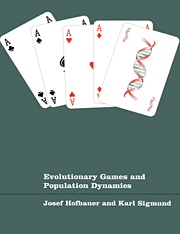Book contents
- Frontmatter
- Contents
- Preface
- Introduction for game theorists
- Introduction for biologists
- About this book
- Part one Dynamical Systems and Lotka–Volterra Equations
- Part two Game Dynamics and Replicator Equations
- Part three Permanence and Stability
- Part four Population Genetics and Game Dynamics
- References
- Index
Introduction for game theorists
Published online by Cambridge University Press: 05 June 2012
- Frontmatter
- Contents
- Preface
- Introduction for game theorists
- Introduction for biologists
- About this book
- Part one Dynamical Systems and Lotka–Volterra Equations
- Part two Game Dynamics and Replicator Equations
- Part three Permanence and Stability
- Part four Population Genetics and Game Dynamics
- References
- Index
Summary
The decline and fall of the rational player
Evolutionary game theory has been a latecomer in the evolution of game theory. The initial aim of game theorists was to find principles of rational behaviour, by means of thought experiments involving fictitious players who were assumed to know such a theory, and to know that their equally fictitious co-players would use it. At the same time, it was expected that rational behaviour would prove to be optimal against irrational behaviour too. It turned out that this was asking for too much.
The fictitious species of rational players reached a slippery slope when the so-called ‘trembling hand’ doctrine became common practice among game theorists. According to this eminently sensible approach, a perfect strategy would take into account that the co-player, instead of being a faultless demigod, occasionally does the wrong thing. How often is ‘occasionally’, one may ask, and what does it matter whether the players lucidly conceived the right move but failed to implement it? From allowing for an infinitesimal margin of error to assuming that the faculties of the players are limited, it takes only a small step; and once the word of ‘bounded rationality’ went the round, the mystique of rationality collapsed. It was like observing that the Emperor was only boundedly covered by his new clothes.
For game theory, the rout of the rational players proved an unmixed blessing.
- Type
- Chapter
- Information
- Evolutionary Games and Population Dynamics , pp. xiv - xixPublisher: Cambridge University PressPrint publication year: 1998

